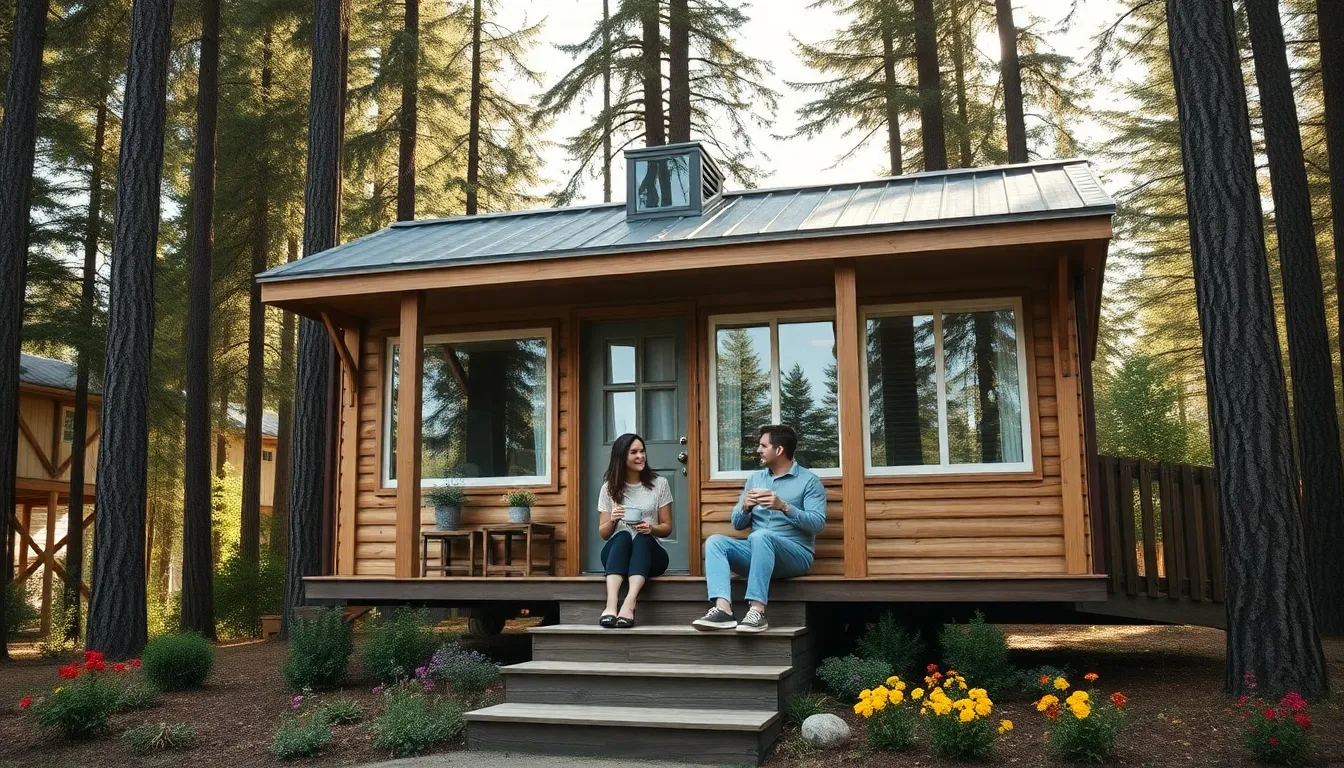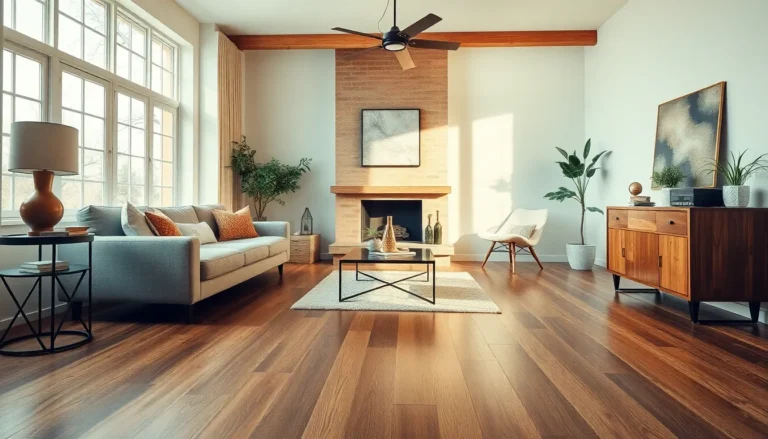Table of Contents
ToggleIn a world where bigger often seems better, wooden tiny homes are here to challenge that notion—one cozy square foot at a time. Imagine living in a space that’s not only charming but also eco-friendly and budget-friendly. These pint-sized abodes pack a punch when it comes to style and sustainability. Who knew that living small could feel so grand?
Wooden tiny homes are like the Swiss Army knives of real estate. They’re versatile, customizable, and perfect for those seeking a simpler, more intentional lifestyle. Plus, they come with a side of whimsy that’ll make your friends green with envy (and maybe a little confused about how you fit your life into such a cute little package). Whether it’s a weekend getaway or a full-time residence, these homes prove that sometimes less really is more.
Overview of Wooden Tiny Homes
Wooden tiny homes stand as a testament to sustainable living. These structures utilize renewable materials, promoting eco-friendliness through reduced carbon footprints. Crafting these homes from wood allows for natural insulation, resulting in energy-efficient living spaces.
Customizability plays a key role in their appeal. Builders often design unique layouts and features, catering to homeowners’ personal tastes and needs. Ingenious use of space, such as multifunctional furniture and lofted sleeping areas, maximizes usability.
Affordability attracts many individuals to wooden tiny homes. The lower construction costs compared to traditional houses often make this option more accessible. Reduced utility bills further enhance economic benefits.
Versatility enhances the charm of these homes. Owners can choose to use them as permanent residences or vacation retreats. Wood’s natural aesthetic meshes well with various environments, from urban settings to serene countryside.
Popularity continues to grow as more people embrace minimalism. Living in a wooden tiny home encourages a lifestyle focused on essentials, eliminating clutter. This shift toward simplicity allows residents to appreciate their surroundings more fully.
Finally, communities around tiny home living foster connection. Neighbors often share resources, such as tools and skills, creating bonds that enrich the living experience. Wooden tiny homes exemplify how compact living spaces can enhance quality of life while promoting sustainability and community values.
Benefits of Wooden Tiny Homes

Wooden tiny homes offer numerous advantages that appeal to a wide range of homeowners. Their charm and practicality resonate with those seeking a simpler lifestyle.
Sustainability and Environmental Impact
Sustainability defines the appeal of wooden tiny homes. These structures utilize renewable materials that minimize environmental footprints. Natural wood provides excellent insulation, reducing energy consumption. Living in a tiny home often leads to a more mindful lifestyle, encouraging occupants to evaluate their consumption habits. Communities focused on tiny homes promote a shared commitment to sustainable living, further enhancing their impact. By choosing a wooden tiny home, individuals support eco-friendly practices while enjoying the beauty of nature.
Cost-Effectiveness
Cost-effectiveness presents another significant benefit of wooden tiny homes. Lower construction costs make these homes accessible for many. Reduced utility bills contribute to long-term savings, allowing homeowners to allocate funds toward other priorities. Many tiny homes require fewer resources to build and maintain, further supporting budget-conscious living. The versatility of these homes offers opportunities for rental income or vacation use, which enhances their financial appeal. Overall, wooden tiny homes represent a smart investment for those looking to maximize value while minimizing expenses.
Design and Features of Wooden Tiny Homes
Wooden tiny homes feature innovative designs that maximize space and incorporate natural materials.
Interior Layout and Space Optimization
Interior layouts of wooden tiny homes often include multifunctional furniture, enhancing storage capabilities. Lofted beds create additional living space, allowing for private sleeping areas. Open floor plans encourage fluid movement, making even the smallest spaces feel larger. Built-in shelves and foldable tables optimize vertical storage without sacrificing comfort. Many designs offer large windows to provide natural light, improving the overall ambiance. These features cater to residents’ needs while promoting a minimalist lifestyle that emphasizes efficiency.
Eco-Friendly Materials and Construction
Eco-friendly materials play a significant role in wooden tiny homes, ensuring sustainability. Often constructed using reclaimed wood or bamboo, these homes reduce waste and lower environmental impact. Natural insulation materials, such as sheep’s wool or hemp, enhance energy efficiency while maintaining comfort. Non-toxic paints and finishes contribute to healthier indoor air quality. Builders prioritize sustainable practices throughout the construction process, utilizing renewable resources. The combination of these eco-friendly materials results in homes that align with environmentally conscious living while maintaining aesthetic appeal.
Challenges of Living in Wooden Tiny Homes
Living in wooden tiny homes presents unique challenges that potential owners should understand. Maintenance and durability serve as crucial aspects of this lifestyle.
Maintenance and Durability
Wooden tiny homes require regular upkeep to ensure longevity. Owners often pay attention to issues like termite damage and moisture control. Regular inspections can prevent major repairs. Seasonal maintenance tasks include checking seals on windows and doors to keep out water. Keeping the exterior painted or sealed helps protect against rot. Furthermore, the use of natural materials can require more frequent attention compared to traditional homes, emphasizing the importance of a committed maintenance routine.
Zoning and Legal Considerations
Zoning regulations significantly impact the feasibility of living in wooden tiny homes. Many areas have specific laws that dictate where tiny homes can be placed. Understanding local codes helps avoid potential legal issues. Some regions prohibit tiny homes on permanent foundations, classifying them as recreational vehicles instead. It’s essential to research building permits, utility access, and any restrictions regarding land use. Working with local authorities can clarify regulations and facilitate a smoother transition into tiny home living.
Wooden tiny homes offer a unique blend of charm and sustainability that resonates with those seeking a simpler way of living. Their eco-friendly features and affordability make them an attractive option for many individuals and families. As the movement towards minimalism grows, these homes encourage a lifestyle that values quality over quantity and fosters a deeper connection to one’s environment.
While challenges like maintenance and zoning regulations exist, the benefits of wooden tiny homes far outweigh the drawbacks. They not only provide a cozy living space but also promote community and mindful consumption. Embracing the tiny home lifestyle can lead to a fulfilling and enriching experience that aligns with modern values of sustainability and financial responsibility.







